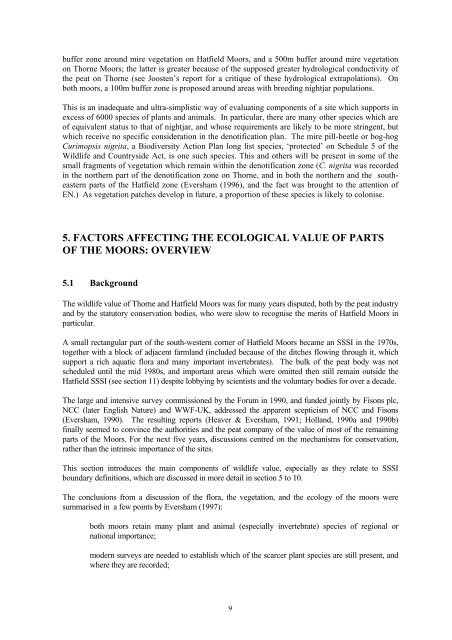free download - Thorne & Hatfield Conservation Forum
free download - Thorne & Hatfield Conservation Forum
free download - Thorne & Hatfield Conservation Forum
Create successful ePaper yourself
Turn your PDF publications into a flip-book with our unique Google optimized e-Paper software.
uffer zone around mire vegetation on <strong>Hatfield</strong> Moors, and a 500m buffer around mire vegetation<br />
on <strong>Thorne</strong> Moors; the latter is greater because of the supposed greater hydrological conductivity of<br />
the peat on <strong>Thorne</strong> (see Joosten’s report for a critique of these hydrological extrapolations). On<br />
both moors, a 100m buffer zone is proposed around areas with breeding nightjar populations.<br />
This is an inadequate and ultra-simplistic way of evaluating components of a site which supports in<br />
excess of 6000 species of plants and animals. In particular, there are many other species which are<br />
of equivalent status to that of nightjar, and whose requirements are likely to be more stringent, but<br />
which receive no specific consideration in the denotification plan. The mire pill-beetle or bog-hog<br />
Curimopsis nigrita, a Biodiversity Action Plan long list species, ‘protected’ on Schedule 5 of the<br />
Wildlife and Countryside Act, is one such species. This and others will be present in some of the<br />
small fragments of vegetation which remain within the denotification zone (C. nigrita was recorded<br />
in the northern part of the denotification zone on <strong>Thorne</strong>, and in both the northern and the southeastern<br />
parts of the <strong>Hatfield</strong> zone (Eversham (1996), and the fact was brought to the attention of<br />
EN.) As vegetation patches develop in future, a proportion of these species is likely to colonise.<br />
5. FACTORS AFFECTING THE ECOLOGICAL VALUE OF PARTS<br />
OF THE MOORS: OVERVIEW<br />
5.1 Background<br />
The wildlife value of <strong>Thorne</strong> and <strong>Hatfield</strong> Moors was for many years disputed, both by the peat industry<br />
and by the statutory conservation bodies, who were slow to recognise the merits of <strong>Hatfield</strong> Moors in<br />
particular.<br />
A small rectangular part of the south-western corner of <strong>Hatfield</strong> Moors became an SSSI in the 1970s,<br />
together with a block of adjacent farmland (included because of the ditches flowing through it, which<br />
support a rich aquatic flora and many important invertebrates). The bulk of the peat body was not<br />
scheduled until the mid 1980s, and important areas which were omitted then still remain outside the<br />
<strong>Hatfield</strong> SSSI (see section 11) despite lobbying by scientists and the voluntary bodies for over a decade.<br />
The large and intensive survey commissioned by the <strong>Forum</strong> in 1990, and funded jointly by Fisons plc,<br />
NCC (later English Nature) and WWF-UK, addressed the apparent scepticism of NCC and Fisons<br />
(Eversham, 1990). The resulting reports (Heaver & Eversham, 1991; Holland, 1990a and 1990b)<br />
finally seemed to convince the authorities and the peat company of the value of most of the remaining<br />
parts of the Moors. For the next five years, discussions centred on the mechanisms for conservation,<br />
rather than the intrinsic importance of the sites.<br />
This section introduces the main components of wildlife value, especially as they relate to SSSI<br />
boundary definitions, which are discussed in more detail in section 5 to 10.<br />
The conclusions from a discussion of the flora, the vegetation, and the ecology of the moors were<br />
summarised in a few points by Eversham (1997):<br />
both moors retain many plant and animal (especially invertebrate) species of regional or<br />
national importance;<br />
modern surveys are needed to establish which of the scarcer plant species are still present, and<br />
where they are recorded;<br />
9


